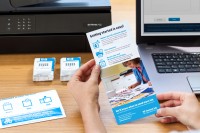 One of the OEM’s ‘inkologists’ said the manufacturer is “analysing the market and determining the best strategy and best customer experience” when asked about expanding the technology to laser printers.
One of the OEM’s ‘inkologists’ said the manufacturer is “analysing the market and determining the best strategy and best customer experience” when asked about expanding the technology to laser printers.
Thom Brown gave the same answer when asked about taking the innovation beyond the 300 page level, during an interview with Castle Ink. The representative said, concerning at what point the device notifies HP that it needs a replacement, that there are seven algorithms that calculate this, based on a low ink threshold and a certain time period, among other elements.
Brown also clarified that the supplies are the same page volume “regardless of plan”, although the 300-page plan user would receive supplies more often than 50-page user. There are currently 17 models capable of using the technology, with any web-enabled, ePrint printer “capable of running Instant Ink”, even if it is one or two years old.
The OEM is confident the technology “will succeed in other markets” after its success in the US, with it now expanding to Canada, the UK, Germany and France.
The ‘inkologist’ said low cost per page was one of the big benefits of the programme, as well as ink delivered straight to the customer’s door, while they can switch devices or programmes whenever they need to.
Brown added: “Customers no longer have to worry about how much ink is being used for a photo or graphic. A page is a page and it’s always the same price making it very easy to budget with a flat cost. The printer is not unique to Instant Ink-only hardware; it can be either.”
The company posed a final situation to Brown about a client who wants to change from a 300-page plan as they are not printing enough to justify the programme, asking if the cartridges would be compromised. He said that the supplies are the same size and said that “original HP inks are also designed and proven not to dry out while sitting idle even up to three months in the home and up to six months in the office”.
